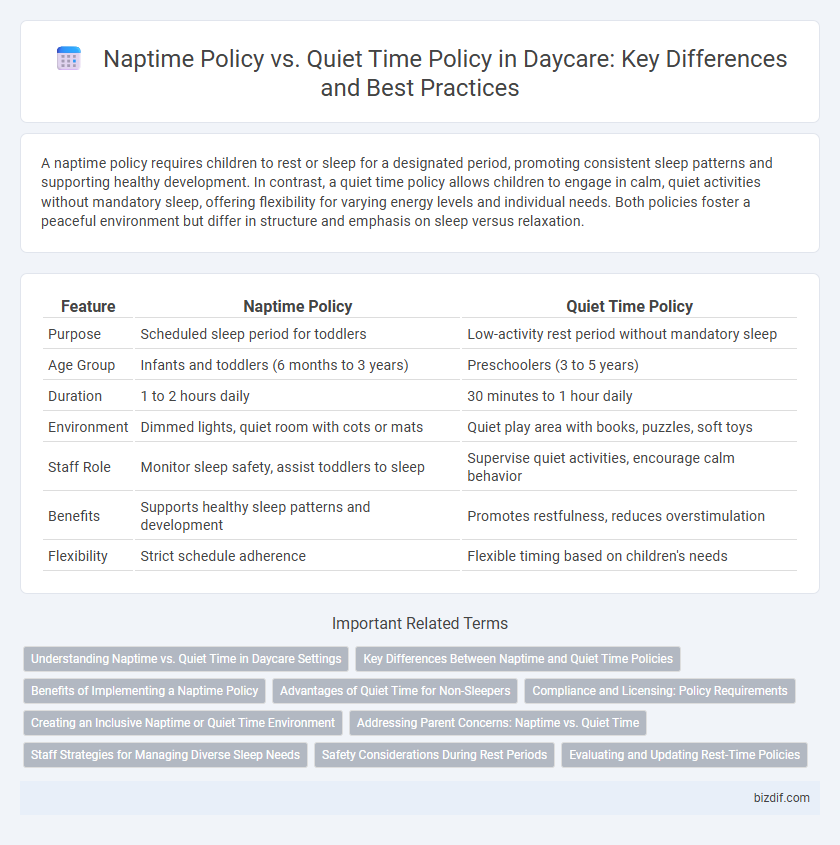A naptime policy requires children to rest or sleep for a designated period, promoting consistent sleep patterns and supporting healthy development. In contrast, a quiet time policy allows children to engage in calm, quiet activities without mandatory sleep, offering flexibility for varying energy levels and individual needs. Both policies foster a peaceful environment but differ in structure and emphasis on sleep versus relaxation.
Table of Comparison
| Feature | Naptime Policy | Quiet Time Policy |
|---|---|---|
| Purpose | Scheduled sleep period for toddlers | Low-activity rest period without mandatory sleep |
| Age Group | Infants and toddlers (6 months to 3 years) | Preschoolers (3 to 5 years) |
| Duration | 1 to 2 hours daily | 30 minutes to 1 hour daily |
| Environment | Dimmed lights, quiet room with cots or mats | Quiet play area with books, puzzles, soft toys |
| Staff Role | Monitor sleep safety, assist toddlers to sleep | Supervise quiet activities, encourage calm behavior |
| Benefits | Supports healthy sleep patterns and development | Promotes restfulness, reduces overstimulation |
| Flexibility | Strict schedule adherence | Flexible timing based on children's needs |
Understanding Naptime vs. Quiet Time in Daycare Settings
Naptime policies in daycare settings require children to sleep for a designated period to ensure adequate rest and support healthy development, while quiet time policies allow children to engage in calm activities such as reading or puzzles if they do not sleep. Understanding the distinction helps caregivers balance individual sleep needs and maintain a peaceful environment conducive to rest. Clear communication of these policies supports consistency in routines, aiding in children's emotional regulation and overall well-being.
Key Differences Between Naptime and Quiet Time Policies
Naptime policies require children to sleep for a designated period, ensuring restorative rest essential for development, while quiet time policies encourage restful activities without mandating sleep, allowing children to engage in calm, independent play or relaxation. Naptime often involves structured, monitored sleep schedules, whereas quiet time offers flexibility, accommodating children who do not need sleep but benefit from downtime. Licensing standards and caregiver guidelines frequently emphasize clear distinctions to support children's varying needs and optimize daily routines in daycare settings.
Benefits of Implementing a Naptime Policy
Implementing a naptime policy in daycare centers enhances children's overall development by promoting consistent rest cycles critical for cognitive growth and emotional regulation. Structured naptime supports improved behavior, attention spans, and physical restoration compared to quiet time policies that allow varying levels of activity and less restorative rest. Research from the National Sleep Foundation emphasizes that scheduled naptime reduces irritability and improves learning outcomes in early childhood settings.
Advantages of Quiet Time for Non-Sleepers
Quiet time policies in daycare provide a calm, restful environment that benefits children who do not fall asleep during naptime by allowing them to recharge mentally without disrupting others. This period promotes quiet activities like reading or puzzles, supporting cognitive development and self-regulation skills. Maintaining a consistent quiet time routine helps reduce overstimulation, encouraging emotional balance and preparing children for the remainder of the day.
Compliance and Licensing: Policy Requirements
Daycare centers must adhere to state licensing regulations that typically mandate a specific naptime policy to ensure children receive adequate rest during the day, which supports their development and well-being. Quiet time policies, while often implemented alongside naptime, may vary more in flexibility but must still comply with state safety and supervision standards to maintain licensing. Compliance with these policies is regularly monitored during licensing inspections to ensure the daycare meets all required health, safety, and developmental guidelines for child care.
Creating an Inclusive Naptime or Quiet Time Environment
Creating an inclusive naptime or quiet time environment in daycare involves respecting diverse sleep needs and cultural practices while providing a calm, soothing space for all children. Use soft lighting, gentle sounds, and comfortable nap mats or cots to accommodate varying comfort levels and sensory sensitivities. Incorporate flexible policies that allow children who do not nap to engage quietly in alternative restful activities, ensuring everyone feels included and supported.
Addressing Parent Concerns: Naptime vs. Quiet Time
Daycare facilities often implement naptime policies to ensure children get adequate rest, improving mood and cognitive function, while quiet time policies provide a flexible alternative allowing children who do not sleep to engage in calming activities. Parents concerned about nap refusal or sleep variability appreciate clear communication about these policies, emphasizing child well-being and individualized rest routines. Transparent guidelines on naptime versus quiet time can alleviate parental anxiety, fostering trust and collaboration between caregivers and families.
Staff Strategies for Managing Diverse Sleep Needs
Daycare staff implement personalized strategies to accommodate diverse sleep needs by distinguishing between naptime and quiet time policies, ensuring children who require sleep receive rest while others engage in calm activities. Techniques include using dim lighting, soft music, and individualized attention to help varying age groups settle comfortably. Monitoring each child's behavior and adjusting routines accordingly promotes a balanced environment that supports both restorative rest and quiet engagement.
Safety Considerations During Rest Periods
Daycare nap time policies prioritize safety by ensuring children are supervised in a secure environment with appropriate sleep positions and individual bedding to reduce risks such as SIDS. Quiet time policies maintain a calm atmosphere without requiring sleep, minimizing movement and noise to prevent overstimulation while allowing flexibility for children who do not nap. Both approaches emphasize monitoring children closely and adhering to health guidelines to protect wellbeing during rest periods.
Evaluating and Updating Rest-Time Policies
Evaluating and updating daycare rest-time policies ensures they meet children's developmental and individual needs effectively. Naptime policies typically mandate specific sleep durations, encouraging restorative rest, while quiet time policies allow flexible rest or calm activities without requiring sleep. Regular assessment of these approaches, informed by caregiver feedback and child behavior observations, enhances overall well-being and supports optimal daily schedules in daycare settings.
Naptime policy vs quiet time policy Infographic

 bizdif.com
bizdif.com